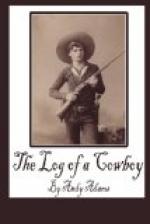I shall never forget the impression left in my mind of that first morning after we crossed Red River into the Indian lands. The country was as primitive as in the first day of its creation. The trail led up a divide between the Salt and North forks of Red River. To the eastward of the latter stream lay the reservation of the Apaches, Kiowas, and Comanches, the latter having been a terror to the inhabitants of western Texas. They were a warlike tribe, as the records of the Texas Rangers and government troops will verify, but their last effective dressing down was given them in a fight at Adobe Walls by a party of buffalo hunters whom they hoped to surprise. As we wormed our way up this narrow divide, there was revealed to us a panorama of green-swarded plain and timber-fringed watercourse, with not a visible evidence that it had ever been invaded by civilized man, save cattlemen with their herds. Antelope came up in bands and gratified their curiosity as to who these invaders might be, while old solitary buffalo bulls turned tail at our approach and lumbered away to points of safety. Very few herds had ever passed over this route, but buffalo trails leading downstream, deep worn by generations of travel, were to be seen by hundreds on every hand. We were not there for a change of scenery or for our health, so we may have overlooked some of the beauties of the landscape. But we had a keen eye for the things of our craft. We could see almost back to the river, and several times that morning noticed clouds of dust on the horizon. Flood noticed them first. After some little time the dust clouds arose clear and distinct, and we were satisfied that the “Running W” herd had forded and were behind us, not more than ten or twelve miles away.
At dinner that noon, Flood said he had a notion to go back and pay Mann a visit. “Why, I’ve not seen ‘Little-foot’ Bill Mann,” said our foreman, as he helped himself to a third piece of “fried chicken” (bacon), “since we separated two years ago up at Ogalalla on the Platte. I’d just like the best in the world to drop back and sleep in his blankets one night and complain of his chuck. Then I’d like to tell him how we had passed them, starting ten days’ drive farther south. He must have been amongst those herds laying over on the Brazos.”
“Why don’t you go, then?” said Fox Quarternight. “Half the outfit could hold the cattle now with the grass and water we’re in at present.”
“I’ll go you one for luck,” said our foreman. “Wrangler, rustle in your horses the minute you’re through eating. I’m going visiting.”
We all knew what horse he would ride, and when he dropped his rope on “Alazanito,” he had not only picked his own mount of twelve, but the top horse of the entire remuda,—a chestnut sorrel, fifteen hands and an inch in height, that drew his first breath on the prairies of Texas. No man who sat him once could ever forget him. Now, when the trail is a lost occupation, and reverie and reminiscence carry the mind back to that day, there are friends and faces that may he forgotten, but there are horses that never will be. There were emergencies in which the horse was everything, his rider merely the accessory. But together, man and horse, they were the force that made it possible to move the millions of cattle which passed up and over the various trails of the West.




